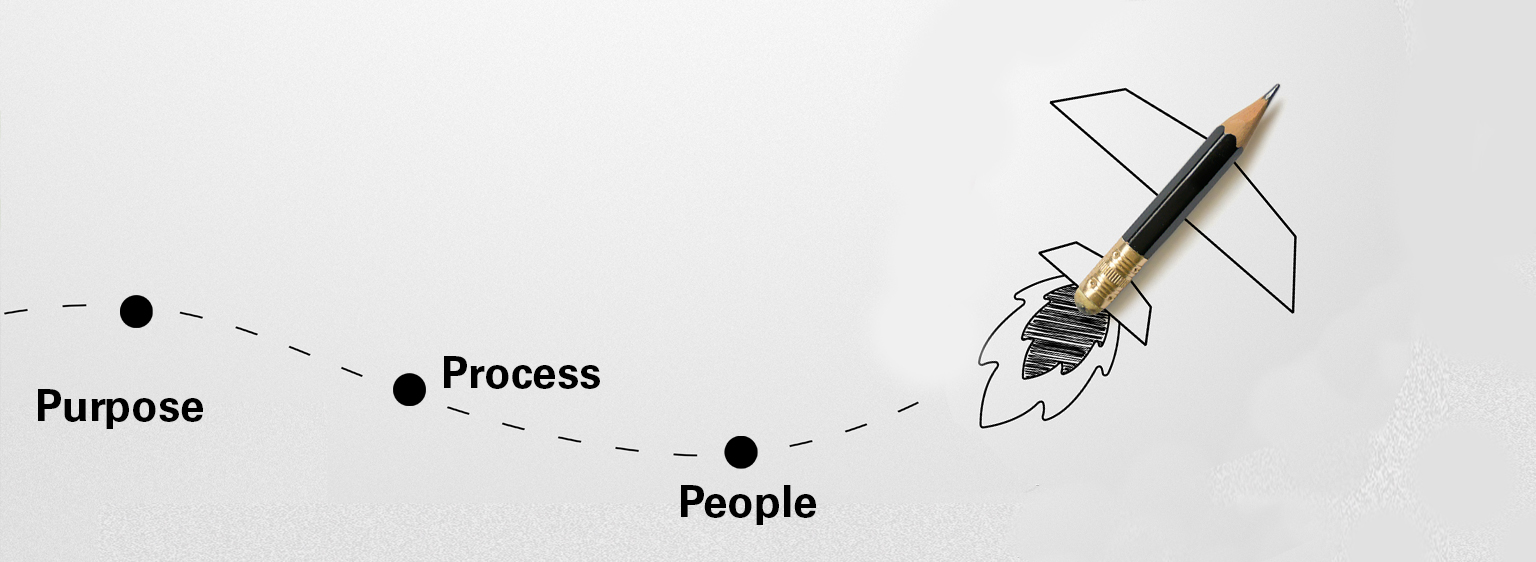How do you begin a lean transformation? There’s no one-size-fits-all approach, but the core elements—purpose, process, and people—remain constant. Last month, LEI President Josh Howell and I witnessed these elements in action during a visit to aerospace manufacturer Re:Build Cutting Dynamics. Just ten months into their journey, the company has already achieved impressive results.
Cutting Dynamics is part of Re:Build Manufacturing, an organization founded by Miles Arnone and Jeff Wilke, former CEO of Amazon’s Worldwide Consumer Business, whose mission is to “rekindle American industry.” Re:Build acquires manufacturers in strategic industries, often with cutting-edge technology, aiming to create a one-stop design, engineering, and manufacturing shop whereby aerospace, mobility, and healthcare companies can go for anything from product design to scaled production.
To begin their transformation, Re:Build Cutting Dynamics management defined a strategic plan built on addressing customer value, chiefly reducing lead time from order to delivery, a challenge in the high-mix low-volume world of precision aerospace manufacturing. In December 2022, leadership convened with a Re:Build lean coach for a week to develop a strategic plan. They decided to focus on improving one value stream––aluminum sheet metal cutting—since it constituted a major portion of their business and offered significant growth potential. They assembled a cross-functional team to map this value stream from order entry to final delivery, visualizing the current state. The opportunities for improvement became their annual plan, which they summarized on an A3.
They visualized the strategy and execution plans on three large whiteboards, collectively referred to as “Mission Control.” The team reviews the boards in a linear sequence, each board serving as a progressive step toward actualizing the strategy. The far-left board shows the annual A3 plan. The middle board tracks the status of all countermeasures related to executing the strategy. And the far-right board displays the complete calendar of activities aimed at reducing lead time from order to delivery. These activities are organized into three categories: rapid-improvement events (RIEs), projects, and just-do-its. Management meets weekly at Mission Control to review the status of action items across the activities and performance to plan for key metrics.
Critically, the purpose of events is not just to solve problems tied to the strategy but to develop people…
Each RIE spans one week and engages a cross-functional team, comprising three distinct segments: a third are process experts who work in the target area, another third are external contributors unfamiliar with the process, and the final third are leaders. Each plays a pivotal role. The experts provide deep insight into the current condition and are responsible for maintaining the improved condition; the outsiders provide fresh eyes and thinking on how to impact the entire value stream versus just the target process; and leaders set a standard of behavior for others to follow. Notably, Re:Build’s CEO Miles Arnone participated in a complete event in 2023, and has signed up for another in January. Twelve other senior leaders, including the COO, CFO, and CCO have participated in the week-long events this year.
Critically, the purpose of events is not just to solve problems tied to the strategy but to develop people, as illustrated by a collaboration with a supplier. To shorten lead times, the company began collaborating with suppliers located within a day’s round-trip distance from their facility. Previously, a crucial heat treatment supplier located out-of-state required a lead time of 42 days. They transitioned to a supplier in neighboring city cutting the lead time to 14 days. Thanks to the proximity, team members could visit the new supplier to study its process. They learned their parts waited up to three days just to be placed into a cart that could be used for heat treatment. Moreover, during handling, operators struggled with an ergonomically unfriendly basket requiring deep bending and reaching, which led to parts banging together. Consequently, up to 60% of the parts came back defective.
They scheduled an RIE to cut the lead time in half and eliminate the defects. An operator named Robert designed and built an ingenious metal cart allowing parts to hang in optimal configuration. The cart materials cost a few hundred dollars and the parts hung on shower curtain hooks. Because the cart can withstand the heat treatment, the supplier never has to handle the parts. They simply wheel the carts into the process and wheel it out. Robert’s solution cut the lead time from 14 to 6 days while eliminating all defects. They continue to work with the supplier with the goal of cutting the lead time in half yet again.
Management admits that they previously had no method of realizing or recognizing operators’ talent. RIEs have become an “engine of improvement,” providing a steady cadence for breakthrough performance driven by frontline workers and forums for previously overlooked individuals to thrive.
Other examples of improvement include:
- Automated an RFQ data entry process that could take an operator up to three days to complete.
- Cut six hours per week in shipping by inserting order slips at shipping as orders are packed from accounting where they were inserted in large batches.
- Created a visual report in shipping, showing completed orders within a customer’s shipment window, thereby eliminating all orders that were complete but not shipped on time.
Re:Build’s Chief Lean Officer Bonnie Davis leads this improvement approach, overseeing transformation at multiple Re:Build group companies, while two coaches work with companies directly to facilitate strategic planning, execute RIEs, and develop local capability. That last responsibility is mission critical. Firstly, the team recognizes that sustainable transformation is possible only with strong problem-solving and management skills across team members. Secondly, Re:Build’s portfolio of companies is growing, requiring development of new coaches to assist leading transformation.
Since beginning their transformation in January, Re:Build Cutting Dynamics has reduced order to delivery lead time from 42 days to 16 days even while volume has increased by 40%. Their goal is to double volume by the end of 2025.
Successful transformation begins by defining a problem to solve, deeply understanding the work to solve the problem, then engaging the team in solving it.
In the coming year, the company plans to extend the RIE model to two more value streams. Simultaneously, they will introduce daily management into the aluminum cutting value stream. This will enable a shift from event-driven improvement to continuous improvement led by daily problem-solving. The transition will challenge their capability to spread problem-solving skills from a few leaders to many frontline workers and managers. The continuous improvement leader, who began as a temp on the shopfloor sixteen years ago, is responsible for executing this plan under the guidance of a lean coach.
The pillars—purpose, process, and people—remain constant. Successful transformation begins by defining a problem to solve, deeply understanding the work to solve the problem, then engaging the team in solving it.
As you assess your approach to transformation, how are you addressing purpose, process, and people?
As this manufacturer has demonstrated, these principles are not just theoretical concepts; they’re actionable steps for successful transformation. If you’re interested in learning directly from such success stories, consider attending the upcoming Lean Summit on March 19-20 in Carlsbad, CA. With the theme ‘Shaping Tomorrow, Developing People,’ the summit offers an opportunity to gain insights into lean transformation, especially in people development.
Excitingly, Re:Build Manufacturing’s Chief Lean Officer Bonnie Davis will host a learning session and Re:Build CEO Miles Arnone will keynote at the summit. We look forward to seeing you there.
Understanding Lean Transformation
Discover pitfalls to avoid and how to lead a successful lean transformation.




